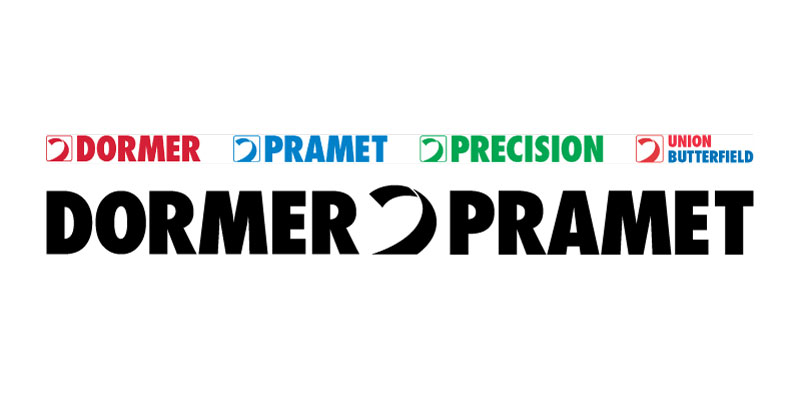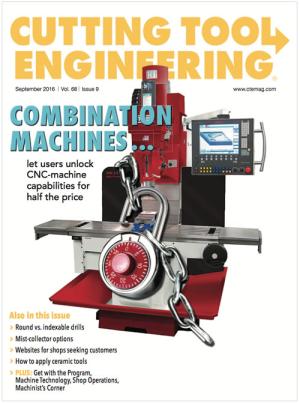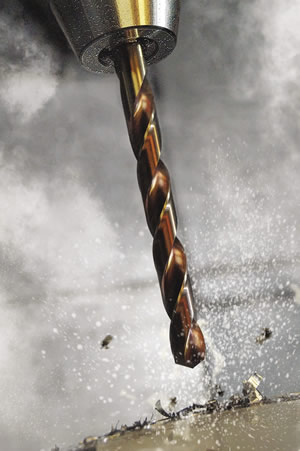 A solid drill is a rotating end- or side-cutting tool with one or more cutting edges and one or more straight or helical grooves for the passage of chips and the admission of coolant. An indexable-insert drill accepts inserts that clamp into a tool body designed to accept them. A cutting edge of an insert is used until it becomes dull, then it is indexed, or turned, to expose a fresh cutting edge. When all cutting edges of an insert are dull, it is usually discarded and replaced with a new one.
A solid drill is a rotating end- or side-cutting tool with one or more cutting edges and one or more straight or helical grooves for the passage of chips and the admission of coolant. An indexable-insert drill accepts inserts that clamp into a tool body designed to accept them. A cutting edge of an insert is used until it becomes dull, then it is indexed, or turned, to expose a fresh cutting edge. When all cutting edges of an insert are dull, it is usually discarded and replaced with a new one.
Hole Diameter
Solid and indexable-insert drills each have advantages and disadvantages, and the type selected for the job depends on the application. Hole diameter is one consideration. Toolmakers can produce indexable drills with much larger diameters than solid tools, while solid drills can be made with significantly smaller diameters.
The diameter of a solid-carbide drill will typically range from about 3mm (0.118") to 20mm (0.787"). A solid-HSS drill can be larger than 20mm in diameter, but it will not be as accurate as a solid-carbide tool. When an application calls for hole diameters larger than 20mm, explore indexable options.
A factor to remember is that the horsepower required for drilling will increase as the drill diameter increases. If a parts manufacturer is purchasing a machine that it knows will be used to drill large diameters, the company must check that the machine has the required horsepower.
Horsepower concerns really come into play when switching to an indexable drill from a solid drill, whether HSS or carbide. With two inserts in use, users must reference the torque and horsepower charts that come with every machine. For example, the charts on machines at Dormer Pramet clearly state that a machine can run at 40 to 45 hp for 15 minutes. Going beyond that point can cause the machine to stop and trigger an alarm.
Tolerances are another differentiator between solid-carbide and indexable drills, with the former able to achieve tighter tolerances than the latter. Using the ISO 286 hole-tolerance scale, where the smaller the number, the more precise a hole’s diameter, a solid-carbide drill can deliver an H9 tolerance while an indexable drill can only reach H10 to H12. So, for example, an 18mm-dia. (0.709") hole that’s H9 on the ISO scale will have a tolerance of 43µm (0.0017"), whereas an H11 hole’s tolerance for the same size hole would be 130µm (0.005").
Investment and Maintenance
From a cost perspective, indexable inserts and their holder—the cutter body that accommodates the inserts—represent a significant investment. However, when a cutting edge is worn and needs replacement, the ease of replacing an insert is more efficient than exchanging a solid tool because only the insert needs to be indexed or changed. A solid drill, on the other hand, usually requires removal from the toolholder and resetting the depth of the drill after the tool is changed.
To help support the long-term investment of indexable inserts, they are interchangeable and versatile. Machinists can reuse the cutter from one job while easily switching out the inserts for another job that requires machining a different workpiece material.
Solid drills offer a long-term investment advantage of their own because they can be reground, sometimes seven to 10 times. On the other hand, indexable inserts are typically not reground.
Performance Standards
The geometry, substrate and coating of a solid drill determine its performance. Drills that optimize each element for a specific application have the potential to be more accurate than general-purpose tools.
Looking at geometry, the 118° conical point is the most common drill point. When properly produced, it will effectively drill a variety of materials. The drill point may require some form of web thinning when used on a drill whose web thickness has increased because of repeated resharpenings or on a drill with a heavy web construction.
In addition, the split point was originally developed for use on drills designed for producing deep oil holes in automotive crankshafts. Today, the split point is used on many designs of drills for cutting various hard and soft materials. The split point can be applied to a variety of drill point angles, with the most common being 135°. The main benefits of the split point are that it enables self-centering of a drill and prevents the tool from “walking” before penetrating a part’s surface.
The split point greatly reduces thrust and adds a positive-rake cutting edge, which extends to the center of the drill. The split point also acts as a chipbreaker to produce small chips, which can be effectively evacuated through the flutes. This is beneficial in most applications, but especially when using a portable drill or a drill press where bushings cannot be used.
Conversely, indexable drills offer a versatility that is beyond the capability of solid tools. Inserts can provide stable results even in adverse conditions and are able to perform multiple operations beyond the scope of solid drills. These operations include plunging, helical interpolation, profiling and enlarging a hole.
For example, when a manufacturer needed to remove material as fast as possible, it plunged with an indexable drill. The company applied a 1"-dia. (25.4mm) drill that plunged straight up and down, then moved it more than ¾" (19.05mm) and plunged straight up and down again. For quickly removing material, it was a great solution—and one a solid drill couldn’t accomplish.
Both solid drills and indexable-insert ones have distinct advantages and disadvantages based on workpiece material, the application and operational requirements. They complete a toolmaker’s standard offering by providing users overlapping diameters so tooling engineers can assess applications and advise parts manufacturers where and when it is appropriate to apply each.

Material differences
HSS is a very tough, but not very wear-resistant, material. HSS tools are applied in many common, demanding applications.
Carbide is the most widely used wear-resistant cutting tool material and is suitable for making solid tools and indexable-insert tools. Approximately 85 percent of all carbide indexable inserts are coated.
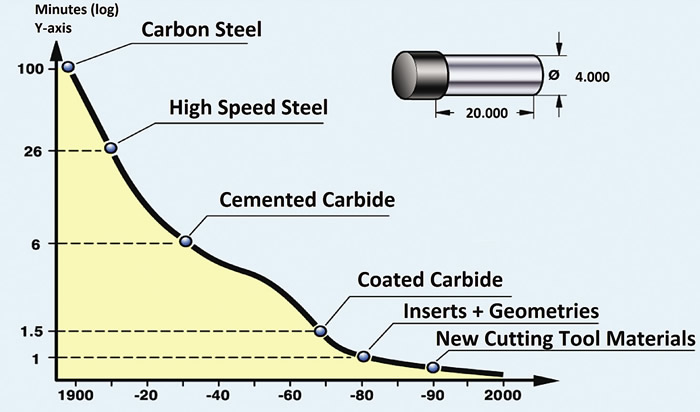
Indexable inserts are made of cermet, ceramics, polycrystalline cubic boron nitride (PCBN) or polycrystalline diamond (PCD).
Cermet provides effective flank- and crater-wear resistance and is not prone to built-up edge. Because of this, the cutting edge maintains its sharpness for a long time.
Ceramic has a wide application area in cutting materials hardened to 45 to 55 HRC and has a high resistance to abrasive and thermal conditions.
PCBN offers an extremely high thermal resistance, and PCBN tools are applied for cutting challenging materials such as hardened steels and cast iron.
There are two types of PCD: natural and industrial diamond. PCD tools are suitable for machining nonferrous materials, such as aluminum, because of PCD’s high resistance to wear. Because PCD is extremely hard and brittle, it is not a good choice for high-hardness or high-impact applications.
Development is ongoing for new geometries, new coatings, new substrates and advanced manufacturing processes, including edge preparations, surface finishing and other treatments.
—G. Kirchoff and J. Nava
Contact Details
Related Glossary Terms
- abrasive
abrasive
Substance used for grinding, honing, lapping, superfinishing and polishing. Examples include garnet, emery, corundum, silicon carbide, cubic boron nitride and diamond in various grit sizes.
- built-up edge ( BUE)
built-up edge ( BUE)
1. Permanently damaging a metal by heating to cause either incipient melting or intergranular oxidation. 2. In grinding, getting the workpiece hot enough to cause discoloration or to change the microstructure by tempering or hardening.
- ceramics
ceramics
Cutting tool materials based on aluminum oxide and silicon nitride. Ceramic tools can withstand higher cutting speeds than cemented carbide tools when machining hardened steels, cast irons and high-temperature alloys.
- chipbreaker
chipbreaker
Groove or other tool geometry that breaks chips into small fragments as they come off the workpiece. Designed to prevent chips from becoming so long that they are difficult to control, catch in turning parts and cause safety problems.
- coolant
coolant
Fluid that reduces temperature buildup at the tool/workpiece interface during machining. Normally takes the form of a liquid such as soluble or chemical mixtures (semisynthetic, synthetic) but can be pressurized air or other gas. Because of water’s ability to absorb great quantities of heat, it is widely used as a coolant and vehicle for various cutting compounds, with the water-to-compound ratio varying with the machining task. See cutting fluid; semisynthetic cutting fluid; soluble-oil cutting fluid; synthetic cutting fluid.
- cubic boron nitride ( CBN)
cubic boron nitride ( CBN)
Crystal manufactured from boron nitride under high pressure and temperature. Used to cut hard-to-machine ferrous and nickel-base materials up to 70 HRC. Second hardest material after diamond. See superabrasive tools.
- drilling machine ( drill press)
drilling machine ( drill press)
Machine designed to rotate end-cutting tools. Can also be used for reaming, tapping, countersinking, counterboring, spotfacing and boring.
- flutes
flutes
Grooves and spaces in the body of a tool that permit chip removal from, and cutting-fluid application to, the point of cut.
- high-speed steels ( HSS)
high-speed steels ( HSS)
Available in two major types: tungsten high-speed steels (designated by letter T having tungsten as the principal alloying element) and molybdenum high-speed steels (designated by letter M having molybdenum as the principal alloying element). The type T high-speed steels containing cobalt have higher wear resistance and greater red (hot) hardness, withstanding cutting temperature up to 1,100º F (590º C). The type T steels are used to fabricate metalcutting tools (milling cutters, drills, reamers and taps), woodworking tools, various types of punches and dies, ball and roller bearings. The type M steels are used for cutting tools and various types of dies.
- interpolation
interpolation
Process of generating a sufficient number of positioning commands for the servomotors driving the machine tool so the path of the tool closely approximates the ideal path. See CNC, computer numerical control; NC, numerical control.
- polycrystalline cubic boron nitride ( PCBN)
polycrystalline cubic boron nitride ( PCBN)
Cutting tool material consisting of polycrystalline cubic boron nitride with a metallic or ceramic binder. PCBN is available either as a tip brazed to a carbide insert carrier or as a solid insert. Primarily used for cutting hardened ferrous alloys.
- polycrystalline cubic boron nitride ( PCBN)2
polycrystalline cubic boron nitride ( PCBN)
Cutting tool material consisting of polycrystalline cubic boron nitride with a metallic or ceramic binder. PCBN is available either as a tip brazed to a carbide insert carrier or as a solid insert. Primarily used for cutting hardened ferrous alloys.
- polycrystalline diamond ( PCD)
polycrystalline diamond ( PCD)
Cutting tool material consisting of natural or synthetic diamond crystals bonded together under high pressure at elevated temperatures. PCD is available as a tip brazed to a carbide insert carrier. Used for machining nonferrous alloys and nonmetallic materials at high cutting speeds.
- polycrystalline diamond ( PCD)2
polycrystalline diamond ( PCD)
Cutting tool material consisting of natural or synthetic diamond crystals bonded together under high pressure at elevated temperatures. PCD is available as a tip brazed to a carbide insert carrier. Used for machining nonferrous alloys and nonmetallic materials at high cutting speeds.
- profiling
profiling
Machining vertical edges of workpieces having irregular contours; normally performed with an endmill in a vertical spindle on a milling machine or with a profiler, following a pattern. See mill, milling machine.
- tolerance
tolerance
Minimum and maximum amount a workpiece dimension is allowed to vary from a set standard and still be acceptable.
- toolholder
toolholder
Secures a cutting tool during a machining operation. Basic types include block, cartridge, chuck, collet, fixed, modular, quick-change and rotating.
- web
web
On a rotating tool, the portion of the tool body that joins the lands. Web is thicker at the shank end, relative to the point end, providing maximum torsional strength.
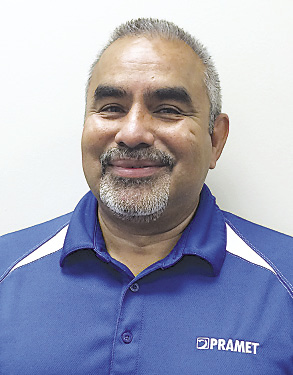 Jesus Nava, also a project manager of round and indexable cutting tools for Dormer Pramet Inc., co-authored this report.
Jesus Nava, also a project manager of round and indexable cutting tools for Dormer Pramet Inc., co-authored this report.

